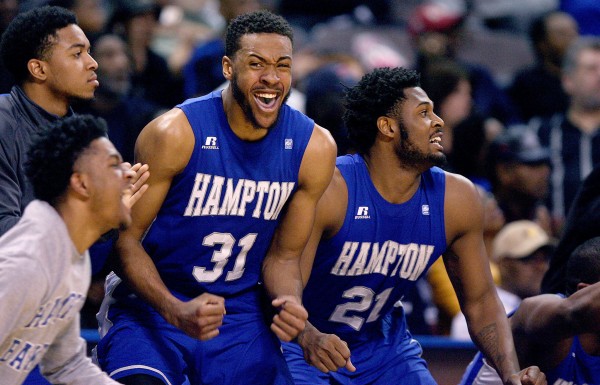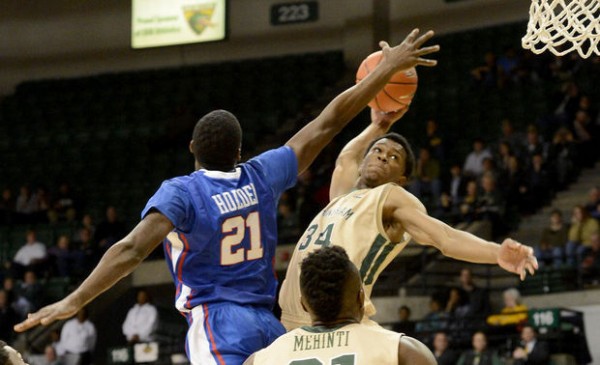Bracket Prep: Albany, Hampton & UAB
Posted by Tommy Lemoine on March 14th, 2015As we move through Championship Weekend, we’ll continue to bring you short reviews of each of the automatic qualifiers to help you fill out your bracket next week. Here’s what you need to know about the most recent bid winners.
Albany

Sam Rowley and the Great Danes are going dancing for the third-straight year. (Gregory Shamus/Getty Images)
America East Champion (24-8, 15-1)
- RPI/Pomeroy/Sagarin = #108/#132/#134
- Adjusted Scoring Margin = +3.1
- Likely NCAA Seed: #14 or #15
Strength: Albany led the America East in both adjusted offensive efficiency (110.2 AdjO) and time taken per offensive possession; which is to say, the Great Danes are slow but effective. They are a solid shooting team from all areas of the floor (36.5% 3FG/48.4% 2FG/76% FT) and do a decent job on the offensive glass, thanks in large part to brothers Sam and Michael Rowley (combined 12.0 RPG). Fellow Australian Peter Hooley (13.8 PPG) – who hit the clutch shot on Saturday – is back to being one of the team’s top offensive weapons after missing several games during conference play to be with his sick mother.
Weakness: The Great Danes often play some zone and like to pack in their defense, which helps them clean up misses (12th-best defensive rebounding rate in college hoops) but precludes them from taking away the three-point line; opponents are shooting nearly 37 percent from three against Albany and scoring around 38 percent of their points from behind the arc. Will Brown’s group surrendered 13 triples against Holy Cross in a 17-point loss back in December and could be overwhelmed by a good outside-shooting team next week.
Key Player: Sam Rowley (14 PPG, 7.7 RPG). The Aussie big man leads Albany in scoring and rebounding, but even that doesn’t quite illustrate his importance. Rowley uses over one quarter of his team’s possessions while on the floor (which is 82 percent of the time), either going to work down low, knocking down mid-range jumpers or passing out of the post. His ability to locate open shooters might be especially important against larger opponents that prevent interior scoring.
Outlook: Albany beat Mount St. Mary’s in the First Four last season and gave #1 seed Florida fits in the round of 64. This time around, the Great Danes won’t head to Dayton and won’t have to face a top-seeded opponent. If the matchup is right, look for Albany to slow the game down, execute offensively and keep things competitive well into the second half. It might not have the athletes to hang for 40 full minutes, but it can certainly make life difficult for an unwitting #2 or #3 seed.
Hampton
- MEAC Champion (16-17, 8-8)
- RPI/Pomeroy/Sagarin = #288/#250/#283
- Adjusted Scoring Margin = -4.8
- Likely NCAA Seed: #16
Strength: Hampton likes to get out in transition and attack the basket, which translates into a bunch of trips to the free throw line. Nearly 25 percent of the team’s offensive production comes at the stripe, a percentage that went up even further during its run in the MEAC Tournament; over the course of four games, the Pirates attempted a whopping 135 free throws (nearly 34 FTA per contest). They also feature very good balance, with five different players averaging between 9.4 and 13.0 points per game. Defensively, Ed Joyner’s group is actually fairly well-rounded and held opponents to the third-lowest effective field goal percentage in conference play.
Weakness: Hampton, seeded sixth in the MEAC Tournament, struggles to shoot the ball from nearly every area of the floor. The Pirates’ 45.7 percent effective field goal rate ranks 304th in America and – although they get to the line a lot – they shoot just 65 percent once there. The result of that dreadful accuracy was one of least efficient offenses in the MEAC and among the 50 worst in the entire country.
Key player: Dwight Meikle (13.5 PPG, 7.5 RPG). Instead of ‘key player’, this should say ‘watch the status of this player’, because Meikle – Hampton’s leading scorer and rebounder – missed the final three games of the MEAC Tournament with an ankle injury. Since the Pirates are such a poor perimeter shooting team, his presence near the basket will probably be crucial next week. Keep an eye on the 6’7” forward’s health.
Outlook: The sub-.500 Pirates might end up having the worst resume of any NCAA Tournament participant this year, but that doesn’t mean they can’t do damage. More than likely, Hampton will play another #16 seed in Dayton, where its guard pressure and attack-heavy offense should keep it competitive – especially if a few shots are falling.
UAB
- Conference USA Champion (19-5, 12-6)
- RPI/Pomeroy/Sagarin = #176/#122/#149
- Adjusted Scoring Margin = +1.4
- Likely NCAA Seed: #15 or #16
Strength: The Blazers are a solid team on both sides of the ball, ranking fourth in Conference USA in both offensive and defensive efficiency this season. They like to attack the basket offensively (70 percent of their shots taken from inside the arc) and do a great job of converting at the free throw line (74% FT). Additionally, Jerod Haase’s group pounds the offensive glass (34% OReb) and has great depth, with eight different guys scoring between 6.0 and 13.0 points per contest. Defensively, UAB uses half-court pressure to limit open looks from behind the arc (opponents shoot well under 32% 3FG) and boasts a pair of good shot-blockers in 6’9” forwards Tosin Mehinti (2.0 BPG) and William Lee (1.6 BPG).
Weakness: UAB is extremely young – sixth-youngest in the country, in fact – with three freshman starters and still more coming off the bench. Whether that factor’s into the team’s inability to take care of the ball, I’m not sure, but there is no doubt that it has a turnover problem. The Blazers’ turnover rate (20.6%) is partly the result of some serious struggles against pressure defenses like Rice (19 turnovers) and Louisiana Tech (20 turnovers in first meeting), so they will hope to avoid a similarly-styled opponent next week. Additionally, outside of freshman Nick Norton (40% 3FG), Haase’s crew struggles to knock down perimeter shots.
Player to watch: Robert Brown (12.8 PPG, 3.7 RPG). The 6’5” Virginia Tech transfer leads the team in minutes, shots and scoring, so his ability to play efficient basketball in the NCAA Tournament is key. Since Haase gives upwards of nine guys meaningful minutes each night, though, there are several players who must step up. Also keep an eye on the freshman Lee (7.6 PPG, 5.8 RPG), the athletic, former Alabama Mr. Basketball who’s scored in double-figures in six of his last seven games.
Outlook: The Blazers parlayed semi-home-court advantage in the Conference USA Tournament into their first NCAA Tournament berth since 2011. They will probably be among the most talented and athletic #15 or #16 seeds, but their youth and inconsistent play away from home – just three wins outside of Birmingham all season – likely prevents them from pulling off an upset.











































